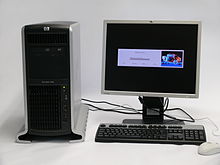
Back إتش بي - يو إكس Arabic HP-UX Catalan HP-UX Czech HP-UX CV HP-UX German HP-UX Esperanto HP-UX Spanish اچپی-یواکس Persian HP-UX Finnish HP-UX French
 | |
| Developer | Hewlett Packard Enterprise |
|---|---|
| Written in | C |
| OS family | Unix (System V) |
| Working state | Current |
| Source model | Closed source |
| Initial release | 1982 |
| Latest release | 2405.11iv3[1] / May 31, 2024 |
| Marketing target | Server |
| Available in | English |
| Package manager | Software Distributor |
| Platforms | Current: IA-64 Former: Motorola 68k, FOCUS, PA-RISC |
| Kernel type | Monolithic with dynamically loadable modules |
| Userland | POSIX / SUS |
| Default user interface | KDE, GNOME and CDE |
| License | Proprietary |
| Official website | www |




HP-UX (from "Hewlett Packard Unix") is Hewlett Packard Enterprise's proprietary implementation of the Unix operating system, based on Unix System V (initially System III) and first released in 1984. Current versions support HPE Integrity Servers, based on Intel's Itanium architecture.
Earlier versions of HP-UX supported the HP Integral PC and HP 9000 Series 200, 300, and 400 computer systems based on the Motorola 68000 series of processors, the HP 9000 Series 500 computers based on HP's proprietary FOCUS architecture, and later HP 9000 Series models based on HP's PA-RISC instruction set architecture.
HP-UX was the first Unix to offer access-control lists for file access permissions as an alternative to the standard Unix permissions system.[citation needed] HP-UX was also among the first Unix systems to include a built-in logical volume manager.[citation needed] HP has had a long partnership with Veritas Software, and uses VxFS as the primary file system.
It is one of three commercial operating systems that have versions certified to The Open Group's UNIX 03 standard. (The others are macOS and AIX.)[2]
- ^ "HP-UX 11i v3 VSE-OE Media". support.hpe.com. Retrieved 2024-04-18.
- ^ "UNIX 03 - The Open Brand Register". The Open Group. Retrieved 2023-03-22.